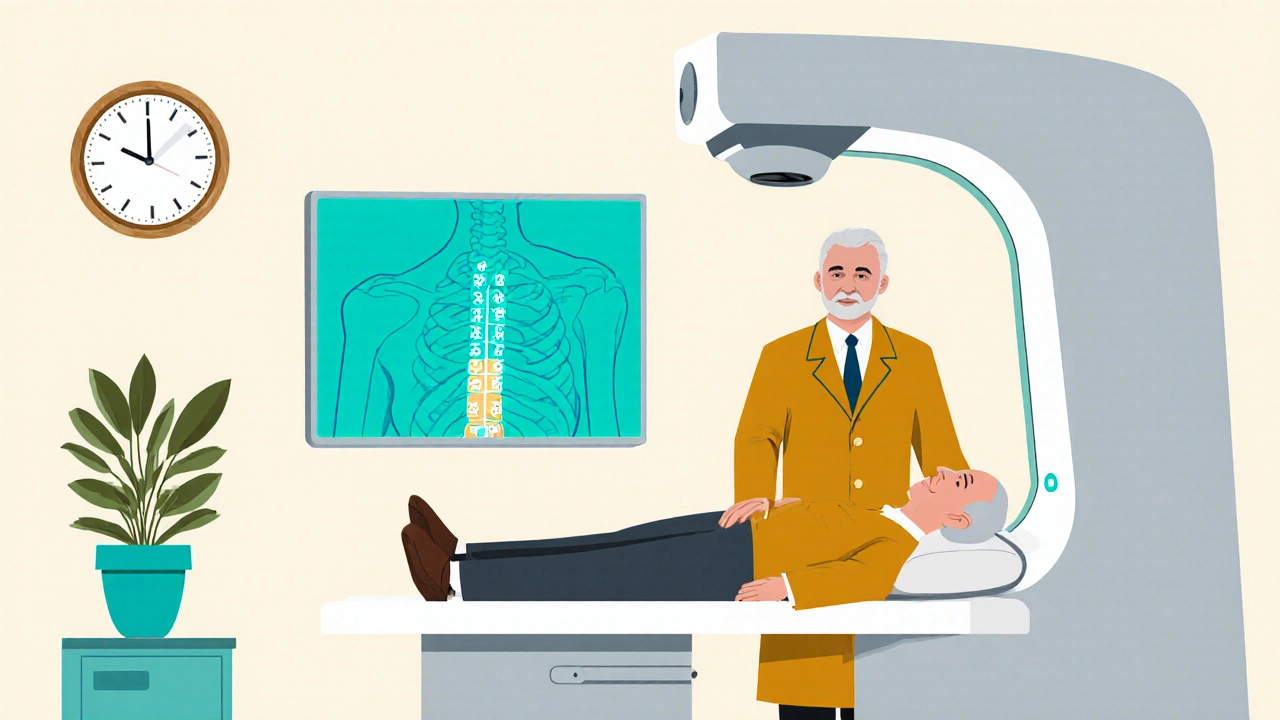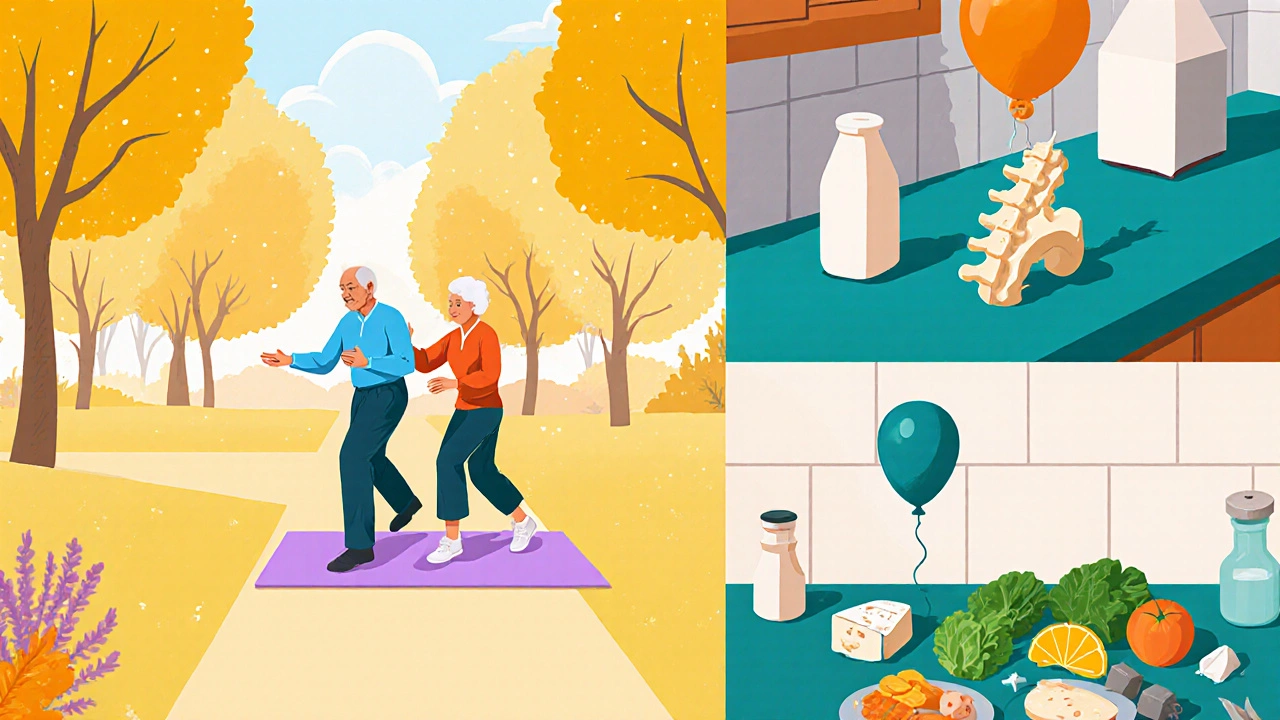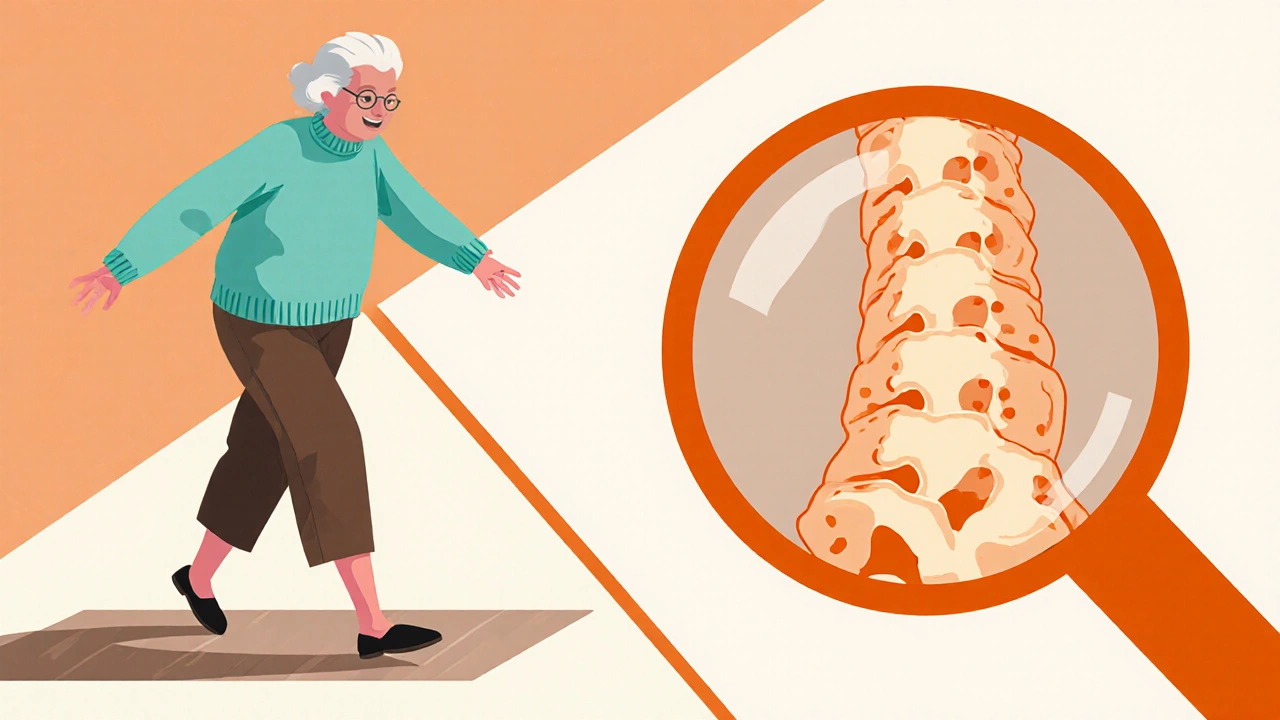Osteoporosis Risk Assessment Tool
Your Risk Assessment
Ever wonder why a simple tumble can turn into a severe back injury for some people? The answer often lies in osteoporosis and the spinal compression fractures it can cause. Below you’ll find a straight‑forward guide that breaks down what’s happening inside the bone, how to spot the warning signs, and what you can actually do to treat or even prevent the problem.
Key Takeaways
- Osteoporosis weakens bone structure, making the spine vulnerable to compression fractures.
- Early symptoms include height loss, back pain, and a hunched posture.
- DXA scans measure bone mineral density (BMD) and confirm diagnosis.
- Medications like bisphosphonates and denosumab, plus lifestyle changes, can halt bone loss.
- Vertebroplasty and kyphoplasty are minimally invasive options for painful fractures.
Understanding Osteoporosis
Osteoporosis is a chronic condition that reduces bone mineral density, making bones porous and fragile. The disease often progresses silently until a fracture occurs, typically in the hip, wrist, or spine. Women post‑menopause are at higher risk due to the drop in estrogen, but men over 70 and anyone on long‑term steroids are also vulnerable.
Bone mineral density (BMD) is measured as a T‑score on a dual‑energy X‑ray absorptiometry (DXA) scan. A T‑score of ‑2.5 or lower confirms osteoporosis, while ‑1.0 to ‑2.5 indicates osteopenia, the “pre‑osteoporosis” stage.
What Is a Spinal Compression Fracture?
Spinal compression fracture occurs when the vertebral body collapses under pressure, often because the bone can’t support normal loads. Most compression fractures happen in the thoracic (T7-T12) and lumbar (L1-L4) regions, where the spine bears the most weight.
These fractures can happen from a low‑impact fall, a sudden twist, or even from everyday activities like lifting groceries if the bones are weak enough. The result is a wedge‑shaped vertebra that shortens the spine, leading to a stooped posture and chronic pain.
How Osteoporosis Leads to Compression Fractures
- Reduced bone mass: Osteoporotic bone loses trabecular thickness, leaving a weaker scaffold.
- Micro‑damage accumulation: Tiny cracks build up over time because remodeling slows down.
- Loss of structural integrity: The vertebral body can’t disperse forces evenly, so a single impact may cause collapse.
Think of a sponge that’s been squeezed dry-once it’s empty, a small poke can tear it apart. That’s essentially what happens inside a weakened spine.

Spotting the Symptoms Early
Because osteoporosis often shows no symptoms until a fracture, staying alert to subtle changes can save you from a painful fall.
- Gradual loss of height (a few centimeters over years).
- New, persistent back pain that worsens with standing or bending.
- A visible hunched posture, sometimes called a “dowager’s hump.”
- Reduced flexibility in the thoracic spine.
- Fracture after a minor slip or even a coughing fit.
If you notice any of these signs, talk to a healthcare provider right away. Early diagnosis can keep the condition from spiraling.
Diagnosing Osteoporosis and Compression Fractures
Here’s the typical path a doctor follows:
- Medical history and risk assessment: Age, gender, family history, steroid use, smoking, and alcohol intake.
- DXA scan: The gold‑standard test for BMD. It takes only a few minutes and involves a very low radiation dose.
- Vertebral fracture assessment (VFA): Often done during the DXA session, it can spot silent fractures.
- X‑ray or MRI: If a fracture is suspected, imaging confirms the exact level and severity.
Blood tests may also be ordered to rule out secondary causes, such as hyperparathyroidism or vitamin D deficiency.
Treatment Options for Osteoporosis
Managing osteoporosis is a blend of medication, nutrition, and movement. Below is a quick rundown of the main approaches.
| Medication | Mechanism | Typical Administration | Common Side Effects |
|---|---|---|---|
| Bisphosphonates (e.g., alendronate) | Inhibits bone resorption by osteoclasts | Weekly oral tablet or yearly IV infusion | Gastro‑intestinal irritation, rare jaw osteonecrosis |
| Denosumab (Prolia) | Monoclonal antibody that blocks RANKL | Subcutaneous injection every 6 months | Skin reactions, low calcium levels |
| Selective Estrogen Receptor Modulators (SERMs) - raloxifene | Mimics estrogen’s protective effect on bone | Daily oral tablet | Hot flashes, increased clot risk |
| Hormone Replacement Therapy (HRT) | Restores estrogen levels | Transdermal patch or oral tablets | Breast tenderness, slight increase in breast cancer risk |
Beyond meds, make sure you get enough Vitamin D (800-1000 IU daily) and Calcium (1200 mg) from diet or supplements. Foods rich in calcium include dairy, fortified plant milks, leafy greens, and sardines.

Managing a Spinal Compression Fracture
When a fracture occurs, the goal is pain control, spinal stability, and preventing future breaks.
- Pain relief: NSAIDs, acetaminophen, or short‑term opioids under doctor supervision.
- Bracing: A rigid thoracolumbar brace can limit motion and reduce pain for a few weeks.
- Physical therapy: Gentle core‑strengthening and posture exercises improve stability.
- Minimally invasive procedures:
- Vertebroplasty - bone cement injected into the collapsed vertebra.
- Kyphoplasty - balloon tamp creates space before cement injection, often restoring height.
- Surgical fixation: Reserved for severe collapse or neurologic compromise.
Most patients experience rapid pain relief after vertebroplasty or kyphoplasty, sometimes within 24‑48 hours.
Prevention: Keeping Your Spine Strong
Prevention isn’t just about taking pills. Your daily habits play a huge part.
- Weight‑bearing exercise: Walking, dancing, or light jogging for 30 minutes most days. Resistance training with bands or light weights helps maintain muscle mass, which supports bone.
- Balance training: Tai chi or simple balance drills can cut fall risk by up to 30 %.
- Nutrition: Aim for a diet rich in calcium, vitamin D, magnesium, and vitamin K2 (found in fermented foods).
- Avoid smoking and limit alcohol: Both accelerate bone loss.
- Home safety: Remove loose rugs, install grab bars, and ensure good lighting to prevent trips.
Even if you’ve already been diagnosed, these steps can slow further bone loss and lower the chance of another fracture.
Quick Checklist for Anyone at Risk
- Schedule a DXA scan if you’re over 65 (or 50 for women post‑menopause).
- Review medications with your doctor; steroids and certain anticonvulsants can weaken bone.
- Start a daily calcium‑vitamin D routine; adjust based on blood test results.
- Pick a weight‑bearing activity you enjoy and stick with it.
- Keep an emergency plan for falls: know who to call and where the nearest urgent‑care center is.
Frequently Asked Questions
Can osteoporosis be reversed?
You can’t turn bone back to its original density, but you can stop further loss and even gain a modest amount of bone with the right meds and lifestyle changes.
Why does my back hurt after a minor bump?
With osteoporotic bone, even a gentle impact can cause a vertebra to compress. The pain comes from the fracture itself and the surrounding muscles reacting to the changed alignment.
Is vertebroplasty safe for older adults?
Yes, it’s considered safe for most seniors. Complication rates are low, and the procedure is performed under local anesthesia, so recovery is quick.
How often should I get a DXA scan?
If you have osteoporosis, repeat the scan every 1-2 years. For osteopenia, a 3‑year interval is typical, unless your risk factors change.
Can I take calcium supplements if I have kidney disease?
Talk to your nephrologist first. High calcium intake can lead to vascular calcification in advanced kidney disease, so dosage may need adjustment.
Knowing the link between osteoporosis and spinal compression fractures empowers you to catch problems early, treat them effectively, and keep your spine upright for years to come.


Albert Fernàndez Chacón
Nice rundown of osteoporosis and compression fractures-straight to the point and easy to follow.
Drew Waggoner
It hits you hard just thinking about a harmless fall turning into a broken spine; the fear lingers long after you finish reading.
Mike Hamilton
i reckon most peopel dont realize how bone health is a reflection of their whole lifestyle, so when it crumbles its like a reminder of all the shortcuts we took.
Matthew Miller
Exactly! Let’s crank up those walking shoes, grab some kale, and smash those bone‑strength workouts-your future self will thank you with a sturdy spine!
Liberty Moneybomb
What they don’t tell you is that the pharma giants push those pills like a secret weapon to keep the elderly dependent, while the real cure is hidden in ancient bone‑building rituals they’ve buried.
Alex Lineses
When it comes to osteoporosis management, integrating pharmacologic agents with biomechanical interventions yields the most robust therapeutic index.
Bisphosphonates act by inhibiting osteoclast-mediated bone resorption, thereby shifting the remodeling balance toward net bone formation.
Denosumab, a RANKL inhibitor, provides a reversible suppression of osteoclastogenesis, which can be advantageous in patients with contraindications to oral agents.
However, clinicians must monitor for hypocalcemia and potential immunologic sequelae during long‑term administration.
Beyond medication, optimizing the patient's calcium–vitamin D axis is essential to ensure adequate mineralization substrate.
Weight‑bearing aerobic activities stimulate osteogenic signaling pathways such as Wnt/β‑catenin, which promote trabecular thickening.
Resistance training contributes to increased muscle mass, which mechanically loads the vertebral column and mitigates micro‑damage accumulation.
Balance training, including tai chi, reduces fall risk by enhancing proprioceptive feedback loops.
For patients already sustaining a compression fracture, vertebroplasty or kyphoplasty can restore vertebral height and alleviate nociceptive input.
These minimally invasive procedures employ polymethylmethacrylate cement, which stabilizes the compromised vertebral body.
Post‑procedure rehabilitation should focus on core stabilization to prevent adjacent segment fracture.
Imaging follow‑up with DXA and vertebral fracture assessment (VFA) permits quantitative tracking of bone mineral density trends.
It is also prudent to conduct periodic laboratory panels to rule out secondary etiologies such as hyperparathyroidism.
Patient education on lifestyle modifications-smoking cessation, moderated alcohol intake, and appropriate nutrition-forms the cornerstone of a holistic care plan.
Interdisciplinary collaboration among endocrinologists, orthopedists, physiatrists, and dietitians ensures that therapeutic decisions are evidence‑based and patient‑centered.
Ultimately, by synergizing pharmacotherapy with targeted physical regimens, we can substantially reduce morbidity associated with osteoporotic spinal compression fractures.
kendra mukhia
Sure, but let’s be real-most of those “evidence‑based” protocols are just lofty hype that those “gurus” love to parade around while real patients keep falling through the cracks.
Bethany Torkelson
Enough with the soft talk-patients need decisive action now, not another lecture about “collaboration” that ends up in endless appointments.
Grace Hada
Truth is, bone weakness exposes the illusion of invincibility we all cherish.
alex montana
Exactly-our bodies betray us, and yet we keep ignoring the signs, we keep pushing forward; but when the spine finally gives, it's a stark reminder that we are mortal,
Wyatt Schwindt
Staying aware of these risk factors and getting regular scans can make a big difference.